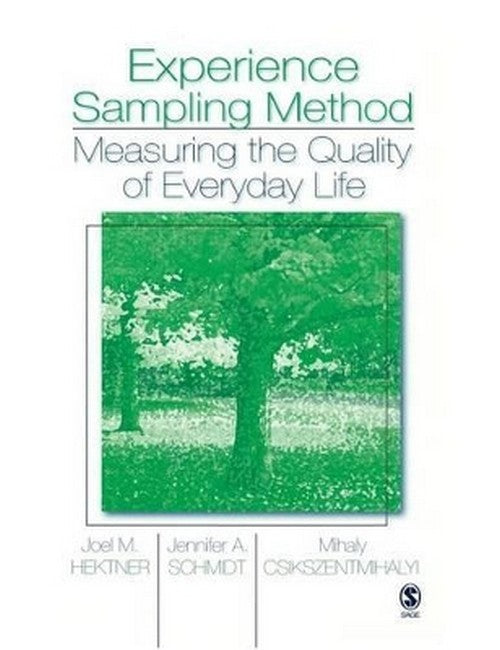Joel M. Hektner is an Associate Professor in Human Development and Family Science at North Dakota State University. He holds a Ph.D. in Psychology: Human Development from the University of Chicago and an A.B. in psychology from Princeton University. Before arriving at NDSU, Hektner was a research scientist in child and adolescent psychiatry at the University of Minnesota. He has used ESM to study the developmental implications of longitudinal changes in adolescent experiences of flow and has written chapters on ESM in several books. In collaboration with students, he has conducted ESM studies of college students, adolescents in residential treatment, and LGB emerging adults. His research interests primarily involve family and peer factors that promote optimal development and evaluations of preventive interventions for antisocial behavior. He is presently working on strategies to strengthen positive peer culture among elementary and middle school children, and to promote more positive parent-child relations. Jennifer Schmidt is Assistant Professor of Educational Psychology at Northern Illinois University. She earned her Ph.D. in Psychology: Human Development from the University of Chicago. Her current research focuses on resilience, motivation, and adolescent engagement in daily challenges. She has been conducting research involving the Experience Sampling Method (ESM) for over 10 years. Dr. Schmidt is former Director of Research at the Alfred P. Sloan Center on Parents, Children, and Work at the University of Chicago, where she directed an ESM study involving parents and children from 500 families across the United States. Her work to date has involved samples of children, adolescents, and adults. She has conducted ESM research within the context of families, elementary schools, middle schools, and high schools. Dr. Schmidt has trained national and international teams of researchers in ESM study design, administration and analysis. Dr. Mihaly Csikszentmihalyi is the Director of the Quality of Life Research Center at the Claremont Graduate School (CGU). His research interests include creativity and innovation, flow and motivation, leadership, work satisfaction, happiness, ethics in business and professions and school-to-work transitions. Dr. Csikszentmihalyi came to the Drucker School at CGU after spending over twenty years at the University of Chicago where he was a Professor of Human Development. He co-founded the "Positive Psychology" movement in The American Psychological Association. Professor Csikszentmihalyi has written numerous articles and his books include the best-selling Flow, Being Adolescent, The Evolving Self, and Creativity. He is a member of the American Academy of Education, the American Academy of Arts and Sciences, and the National Academy of Leisure Sciences.
Request Academic Copy
Please copy the ISBN for submitting review copy form
Description
List of Tables and Figures Acknowledgments Part I: The Origins of ESM Chapter 1: Epistemological Foundations for the Measurement of Experience A Systematic Phenomenology The Experience Sampling Method A Brief History How Trustworthy Are Subjective Self-Reports? What Can We Learn From ESM? Chapter 2: Theoretical Foundations of ESM Biology, Culture, and Daily Behavior Subjective Experience in Context: The Interplay of Psychological Processes and Cognitive Functions Interaction of Individuals and Environments Experience Fluctuations, Well-Being, and Development A Theoretical Compass for Exploring Experience Part II: How to Measure the Quality of Everyday Life Chapter 3: Collecting the Data Designing a Study Using ESM Equipment and Signaling Schedules Designing the Form Other Design Decisions Implementing the Study Documentation Chapter 4: Dealing With the Data: Coding, Entry, Cleaning, and Data Management Developing a Codebook Coding the External Coordinates of Experience Conding the Internal Coordinates of Experience What to Do With the Codes Once They Are Developed: Physically Coding and Entering the Data Setup, Cleaning, and Manipulation of Data Files Response-Level Data and Person-Level Data Postentry Data Manipulation Data File Management and Documentation Chapter 5: Types of Analyses Qualitative Approaches Graphic and Numeric Descriptive Information Planning for Statistical Analyses OLS Statistical Techniques Multilevel and Other Complex Statistical Techniques Chapter 6: Psychometrics of ESM Data Validity of Method Validity of ESM Measurements Reliability of ESM Measurements Part III: Uses of ESM in Social Science Research Chapter 7: Samples of Experience The Who, What, Where, When, and How of Daily Experiences Quality of Experience in Selected Activities Quality of Experience of Selected Groups of People Emotions, Well-Being, and Flow Chapter 8: The Experience of Males and Females Differences in Activities Differences in Companionship Similiarities and Differences in Emotional Experience Other Gender Differences in Adolescence Chapter 9: The Experience of Family Life Methodological Concerns and Variations The Couple Relationship The Arrival of the First Child Juggling Work and Family Roles The Adolescent's Experience of Family Transmission of Emotions Between Family Members Comparisons Between Families: Optimal Conditions for Adolescent Development Chapter 10: The Experience of Work Methodological Concerns and Variations Time and Work The Quality of Experience at Work: General Trends The Quality of Experience Across Workers The Quality of Experience Across Work Activities The Intersection of Work and Family The Experience of Unemployment Adolescent Work Chapter 11: Examining Cross-Cultural Differences Methodological Concerns and Variations Culture and Time Use Cross-Cultural Variation in General Affective Experience Culture and Subjective Experience in Various Activities Cross-Cultural Examination of Flow Studies of American Subcultures Chapter 12: Educational Applications Methodological Concerns and Variations Time Use and Structure of Classrooms The Quality of Students' Classroom Experiences Comparing Students' Classroom Experiences After-School Programs Studies of Adult Learners The Experience of Teachers Chapter 13: Clinical Applications Methodological Concerns and Variations Use of ESM for Describing and Contextualizing Experiences of Disorder Use of ESM in Therapy and in Treatment Evaluation Concluding Thoughts Ten Major Issues ESM Illuminates Appendix A: Sample ESM Data Collection Forms (ESFs) Appendix B: ESM Coding Scheme Used in the Sloan Study of Youth and Social Development References Index About the Authors
"This book provides interesting reading for students in research method courses and belongs on the must-read list of investigators who are considering the application of ESM to their own research." -- Susan L. Trumbetta

